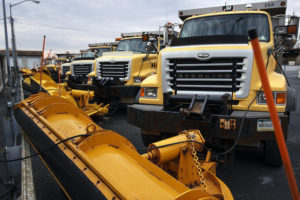
As colder temperatures and the potential for winter weather move through southeast Pennsylvania, the Pennsylvania Department of Transportation (PennDOT) District 6 highlighted its plans for the winter season.
“Our dedicated staff is ready and well-resourced to deliver the best possible winter service under the worst conditions,” said PennDOT Assistant District 6 executive for maintenance John Krafczyk. “Whatever mother nature brings this winter, PennDOT will be prepared.”
PennDOT District 6 is responsible for over 11,000 snow lanes miles on state highways in Bucks, Chester, Delaware, Montgomery and Philadelphia counties. A snow-lane is calculated as the miles of road multiplied by the number of lanes, which means a one-mile section of four-lane roadway would equal four snow-lane miles.
With $29.8 million budgeted for this winter’s operations in the region, the District 6 fleet consists of 182 state snow trucks and 257 private contractor trucks. The number of contractor trucks used for each event is determined by the severity of each storm. The snow trucks are equipped with computerized salt spreaders that allow the operators to calibrate the exact amount of salt to be distributed regardless of the truck’s speed.
Assisting PennDOT this winter in the Philadelphia region are 93 municipalities that entered into winter maintenance agreements covering more than 3,600 snow miles lane, whereby local crews salt and plow specified state roads in each municipality.
Due to a below-average winter last year, District 6 has more than 125,000 tons of salt and 170,000 gallons of salt brine stockpiled across the region. These are the essential materials our state and contractor crews will use to help keep state highways passable during winter weather events.
When winter weather hits, PennDOT’s primary focus is on interstates, expressways and other major routes. Equipment may be redirected to those highways during significant winter events. If motorists encounter a snowplow on the roadway, they should slow down and drive at least six car lengths behind the plow to ensure safety for everyone. Motorists should never pass a snowplow because plow blades are wider than the truck.
“Please watch out for our trucks,” Krafczyk added. “Our equipment operators have an enormous amount of responsibility during a storm as they plow snow; monitor computers that control the flow of salt; track pavement temperatures; and watch for traffic and possible roadside obstacles.”
If motorists encounter snow or ice-covered roads, they should slow down, increase their following distance and avoid distractions. Last winter in Pennsylvania, there were 151 crashes resulting in three fatalities on winter-weather roadways where aggressive-driving behaviors such as speeding or making careless lane changes were factors in the crash.
PennDOT recommends that motorists prepare for potential bad weather by carrying an emergency kit in their vehicles. The kit should include non-perishable food, water, first-aid supplies, small shovel, cell phone charger and any other items necessary for families to have, such as baby or pet supplies, and medications. For more information on preparing for winter, visit www.PennDOT.gov/winter.
PennDOT is actively seeking temporary equipment operators for the winter season to supplement the department’s full-time staff. Details on minimum requirements, such as possession of a CDL, as well as application information, are available at www.employment.pa.gov.





